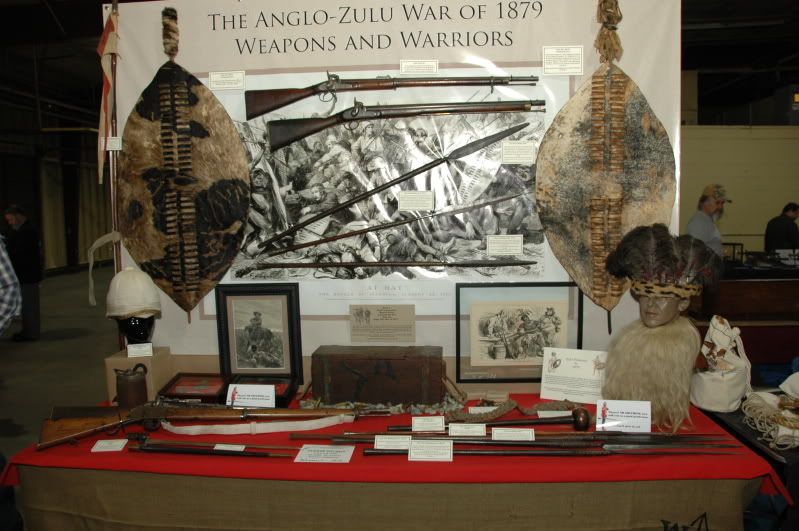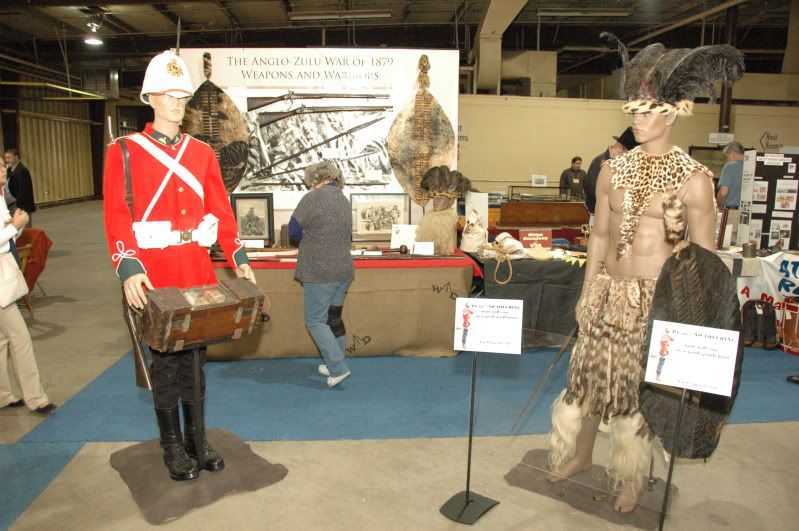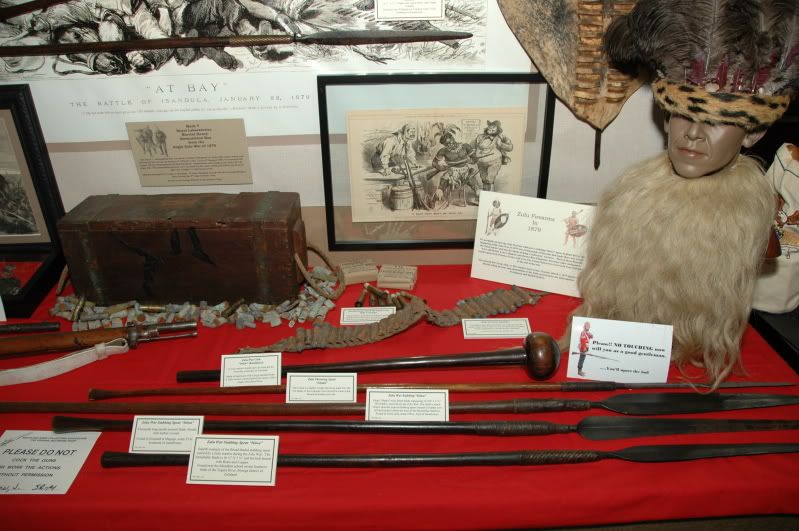
 |
|
|
#1 |
|
(deceased)
Join Date: Dec 2004
Location: OKLAHOMA, USA
Posts: 3,138
|
I THOUGHT IT WOULD BE INTERESTING TO HAVE A POST WHERE WE CAN ADD PICTURES AND INFORMATION ON THE ZULU NATION.
I WILL START OFF WITH A STRANGE ITEM I REFER TO AS A KNOBSPEARIE IS IT REAL OR SOMETHING MADE UP ? COMMENTS WELCOME 4 PICTURES OF KNOBSPEARIE AND ONE OF ZULU TODAY AND A PAINTING OF THE FIGHT AT BORKES RIFT (BRITISH AGAINST ZULU) |
|
|

|
|
|
#2 |
|
Member
Join Date: Mar 2006
Location: Room 101, Glos. UK
Posts: 4,264
|
zulus didn't use socketed spearheads. they used a tanged blade set in a hole drilled in the end of the shaft & reinforced with leather or wirework
looks like someone stuck that spearhead on a knobkerrie. |
|
|

|
|
|
#3 |
|
Member
Join Date: Aug 2007
Posts: 865
|
I don't know much about this area...but I don't know if you would also like to add Zulu movies? I can think off the top of my head: Shaka Zulu & the movie Zulu Dawn. Any comments too on their historical, including ethnographic accuracy? If it's too corny...pretend I didn't mention it

Last edited by Nathaniel; 30th December 2010 at 03:37 AM. |
|
|

|
|
|
#4 |
|
(deceased)
Join Date: Dec 2004
Location: OKLAHOMA, USA
Posts: 3,138
|
THERE HAVE BEEN QUITE A FEW GOOD MOVIES AND THE TV SERIES ON SHAKA. THE ONES I HAVE SEEN OFTEN DEAL WITH THE BRITISH FAMOUS BATTLES FROM THEIR POINT OF VIEW AS THE VICTORS. THEY ARE GOOD MOVIES AND HISTORICALLY ACCURATE UP TO A POINT BUT I WONDER IF ANYTHING HAS BEEN DONE BY THE ZULU THEMSELVES AS THEIR POINT OF VIEW WOULD HAVE BEEN DIFFERENT. ZULU DAWN IS ONE OF THE BETTER MOVIES AND ENTERTAINING BUT DEALS MOSTLY WITH THE BESIEGED BRITISH THERE IS NOT MUCH FROM THE ZULU PERSPECTIVE.
HERE ARE TWO OLD PICTURES OF AFRICAN TRIBES WITH A ZULU IN EACH. THE DIFFERENT DIVISIONS WORE DIFFERENT UNIFORMS I AM NOT SURE HOW MANY DIFFERENT DIVISIONS THERE WERE AND IF THEY WERE BASED ONLY ON ZULU TRIBES OR THOSE CONQUERED OR ALLIED WITH THEM. THE UNIFORMS ALSO DENOTED RANK. THERE ARE TWO MODERN PICTURES OF ZULU STICK FIGHTING WHICH IS STILL PRACTICED TODAY. AND ONE GOOD OLD PICTURE OF A ZULU WARRIOR NOTE THE STAFF. I TEND TO AGREE THAT THE SPEAR POINT IS NOT WHAT I HAVE SEEN ON ZULU WEAPONS AS MENTIONED ALL I HAVE SEEN HAVE A TANG NOT A SOCKET. IT WAS PROBABLY ADDED TO THE KNOBKERRY OR SHIELD STICK WHICH MAY OR MAY NOT BE ZULU. LOOKS LIKE IT COULD HAVE BEEN EITHER CEREMONIAL OR PERHAPS SOMETHING COBBLED TOGETHER BY A SOLDIER OR SELLER? |
|
|

|
|
|
#5 |
|
Member
Join Date: Dec 2004
Location: Inland Empire, Southern California USA
Posts: 160
|
Secrets of the Dead PBS seris about the Zulu is an interesting look at the famous British battle at Isandlwana.
http://www.pbs.org/wnet/secrets/prev...ulu/index.html A few Zulu pieces from my collection |
|
|

|
|
|
#6 |
|
Member
Join Date: Aug 2005
Location: Australia
Posts: 373
|
Umm, Rorke's drift as opposed to Borke's rift

|
|
|

|
|
|
#7 |
|
Member
Join Date: Dec 2004
Location: What is still UK
Posts: 5,939
|
Like that spear Barry. Thought I might add this thread.
http://www.vikingsword.com/vb/showth...+zulu+interest |
|
|

|
|
|
#8 | |
|
Member
Join Date: Dec 2004
Location: Inland Empire, Southern California USA
Posts: 160
|
Quote:
|
|
|
|

|
|
|
#9 |
|
(deceased)
Join Date: Dec 2004
Location: OKLAHOMA, USA
Posts: 3,138
|
OOPS! RORKES DRIFT IT IS
 SOME REFRENCES ON THE ZULU ARE 1. OSPREY MEN AT ARMS SERIES " QUEEN VICTORIAS ENEMIES (1) SOUTHERN AFRICA 2. OSPREY MILITARY ELITE SERIES "THE ZULUS" 3. SOME INFORMATION IN AFRICAN ARMS AND ARMOR BY CHRISTOPHER SPRING THE OSPREY ARMS BOOKS ARE MORE COMPREHENSIVE LESS EXPENSIVE AND EASIER TO FIND AND HAVE GOOD COLOR PICTURE PLATES. NICE ZULU ITEMS NOT OFTEN SEEN IN THE USA PERHAPS MORE COMMON IN EUROPE. I HAVE SEEN SOME IN MUSEUMS BUT ONLY ONE COMPLETE SET FOR SALE HERE. |
|
|

|
|
|
#10 |
|
Member
Join Date: Nov 2010
Location: Wirral
Posts: 1,204
|
As already stated , that certainly is not a Zulu spear .. I am not wholly convinced that it is a knobkerry either .. the head seems very small to those I have seen and own ... though I have seen some Bantu staffs with small rounded heads like that. It may even be a valid piece in its own right with the knobbed end acting as a counter balance... I wonder if any of the spear experts on this forum can identify it ?
|
|
|

|
|
|
#11 |
|
Member
Join Date: Aug 2007
Posts: 865
|
Here are some pics I took last year at Baltimore of a display:
   
|
|
|

|
|
|
#12 |
|
(deceased)
Join Date: Dec 2004
Location: East Coast USA
Posts: 3,191
|
Barry the spear in question is a composite the head is Danakil the shaft is a knobkerrie.
|
|
|

|
|
|
#13 |
|
Member
Join Date: Jan 2006
Location: Kent
Posts: 2,658
|
Totally agree with Lew, a composite. The Danekil spearhead socket would normally be 'flush' (or almost )with the shaft , this one is not and looks out of place. Due to the British involvement in Somalia and South Africa, perhaps the items ended up in a 'British' collection ....later married together either by innocent ignorance or monetary deception.
The idea of the knob being a counter balance is quite plausable though. In Spring's 'African arms and armour' page 38 is a picture of a Lancer of the Sultan of Bagrima's cavalry. The two headed lance is counter weighted with a 'knob' (material unknown) I do not have a scanner so can't post the picture. Happy New Year to you all David |
|
|

|
|
|
#14 |
|
(deceased)
Join Date: Dec 2004
Location: OKLAHOMA, USA
Posts: 3,138
|
THIS RECENTLY CLOSED ON EBAY . I LIKED IT AND BID BUT THERE WERE OTHERS WHO LIKED IT AS WELL WITH MUCHO DINERO.
IT IS DESCRIBED AS A ZULU PRESTIEGE BATON, ALSO USED FOR DANCING. 28 INCHES LONG. I HAD NOT SEEN ANYTHING LIKE IT INCLUDE IT HERE IN THE ZULU SECTION. ITS SAID TO BE FROM 1899. |
|
|

|
|
|
#15 |
|
(deceased)
Join Date: Dec 2004
Location: East Coast USA
Posts: 3,191
|
Barry
I was one of the bidders and yes it went for a grand or more  . It's probably northern Ngoni and highly stylized. . It's probably northern Ngoni and highly stylized.
|
|
|

|
|
|
#16 |
|
Member
Join Date: Dec 2004
Location: What is still UK
Posts: 5,939
|
Yes a beautiful club. I had an eye on it but that was all I could do.
|
|
|

|
|
|
#17 | |
|
Member
Join Date: Jul 2006
Location: Buraimi Oman, on the border with the UAE
Posts: 4,408
|
Quote:
Salaams Nathaniel~ As an exercise in historical accuracy it is well worth viewing the film Zulu and then going after the evidence so as to compare fact with fiction. Although Zulu is a good boys own classic it is nontheless full of inaccuracy and poetic licence. For a start this was not a Welsh Regiment so the reliance on stirring Welsh singing is entirely misplaced. There was no honour shown by either side and when reinforcements arrived all injured enemy were executed point blank on the battlefield. However it is still "a good film" !! Regards, Ibrahiim al Balooshi. |
|
|
|

|
|
|
#18 |
|
Member
Join Date: May 2011
Location: Swaziland
Posts: 6
|
Agreed that this particular example is a composite of two different tribal artefacts. However there are many examples of authentic knobkerrie spear combinations. In fact the South African group known as the Knobnoses produced spears which were almost always had protuberances at the end of their spear hafts.
|
|
|

|
|
|
#19 |
|
Member
Join Date: May 2011
Location: Swaziland
Posts: 6
|
Hi, just a quick correction to Nagawarrior. The old photo that you show & mention as Zulu is not Zulu but a Zulu offshoot known as Ngoni or Angoni they live in small kingdoms in Malawi, Tanzania, Zambia & Mozambique. The tufted spear indicate this as part of the Maseko Ngoni under king Gomani in Malawi & Mozambique.
|
|
|

|
 |
|
|